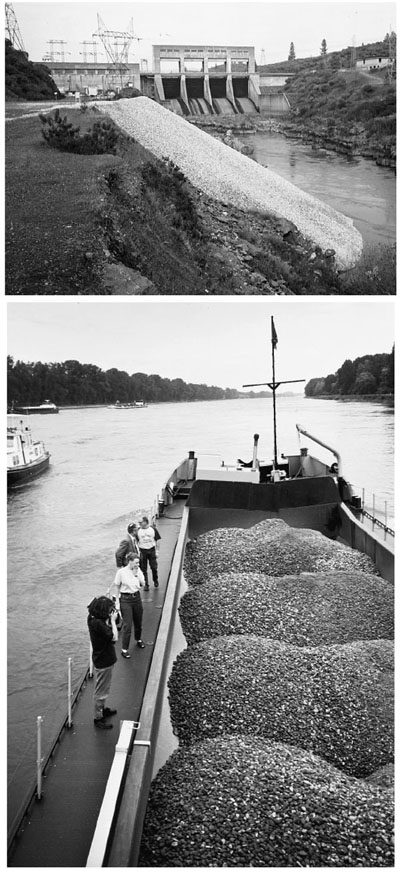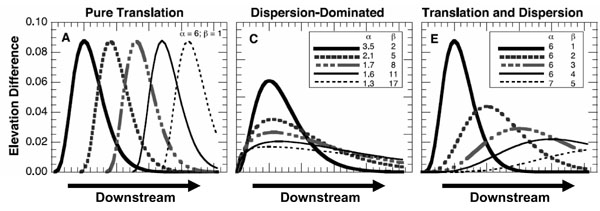Add sediments
Contents
- 1 Add sediments
- 1.1 General description
- 1.2 Applicability
- 1.3 Expected effect of measure on (including literature citations):
- 1.4 Temporal and spatial response
- 1.5 Pressures that can be addressed by this measure
- 1.6 Cost-efficiency
- 1.7 Case studies where this measure has been applied
- 1.8 Useful references
- 1.9 Other relevant information
Add sediments
Add sediments06. In-channel structure and substrate improvement
General description
The incision of the riverbeds has been widely observed on many streams of mobile bed. Incised channels occur when stream power exceeds the channel bed’s resistance, or when sediment output exceeds the sediment input to the reach. Human alterations causing channel incision are upstream dams, straightening, bank revetment, construction of levees, large wood removal, changes in land use, etc.
As a result, high flows erode gravel and often cause the formation of a paved or armoured channel-bed. Medium sized gravel suitable for spawning of anadromous fish is not replenished by upstream supply or bank erosion and becomes scarce or is completely absent as well as erosional and depositional features that results from natural sediment dynamics like pools and riffles. Moreover, armouring of the channel-bed decreases the surface-subsurface water exchange and the interstitial spaces available for colonization by invertebrates.
The most efficient long-term solution is to restore a natural flow and sediment regime, e.g. by decreasing urban runoff, restoring river continuity for sediment transport or allowing natural channel dynamics and bank erosion.
If options for river restoration are limited, gravel augmentation (or ‘‘replenishment’’), the artificial supply of bed load–sized sediments to channels, is an appropriate mitigation measure to partially compensate for a sediment deficit. (Kondolf, 1994, 1997, Sklar et al. 2009).
In general, there are two different ways to add sediment:
- gravel placement at several locations, shaping bars or riffles to provide direct habitat benefits,
- gravel injection to provide sediment which is eroded and transported downstream to decrease the sediment deficit downstream of dams (called “passive gravel augmentation” by Bunte 2004).
Only the latter is considered in this fact-sheet. Restoration projects which focus on the direct creation of spawning habitat by one-time gravel additions in river reaches with low erosion potential are described in the fact-sheet “Recreate gravel bars and riffles”.
To optimize the beneficial effects, gravel augmentation is often accompanied by other measures like establishing environmental flows capable of transporting the added sediment and reduction of fine sediment input to avoid clogging.
Applicability
Passive gravel augmentation can only successfully be applied if frequently occurring high flows can transport and distribute the added sediment. Thus, gravel injection should seek a stream location where entrainment occurs at relatively low flows (e.g. at narrows). Otherwise, gravel will not be available to improve downstream reaches until after the next, infrequent high flows (Bunte 2004).
Gravel injection creates an artificial pulse of locally enhanced sediment supply. In principle, these sediment pulses either propagate downstream as a translating wave or disperse in place or as a combination of dispersion and translation (Figure 2).
Depending on the restoration objectives, dispersion or translation may be the preferred sediment pulse propagation. Dispersion may be preferable to enhance the input reach since it will produce the longest-lasting benefits at the input reach, while pulse translation will result in short-lived local benefits. Moreover, slow dispersion without significant translation may be preferable to avoid scour of salmonid redds and when unique local conditions limit the potential benefits of enhanced sediment supply downstream. Conversely, translation may be a desired outcome when access points for sediment delivery are limited but a long downstream reach could potentially benefit from the added gravel (Sklar et al. 2009).
The success of passive gravel augmentation focusing on translation depends on undisturbed downstream gravel conveyance to ensure that the added gravel does not accumulate in some few gravel sinks but is available for deposition and habitat enhancement at numerous locations. The longer the stretch through which the added gravel travels while creating spawning habitat on the way, the more “mileage” one gets from a specified volume of added spawning gravel. The final deposition should occur in an area suitable to deal with the effects of this material (Bunte 2004).
Results from a flume study indicate that dispersive pulse evolution is favoured by coarser sediment inputs, wider grain size distributions, and larger input volumes (Sklar et al. 2009).
Expected effect of measure on (including literature citations):
There is some grey literature on gravel-augmentation practices (e.g. Bunte 2004) and open literature on modelling approaches (Sklar et al. 2009). However, there are no empirical studies published in open scientific literature describing the hydromorphological or ecological effects of sediment addition below dams (see also Bunte 2004). Therefore, the assessment of the expected effect of sediment addition is based on pure expert judgement.
The ecological effect probably strongly depends on the amount of gravel added and the frequency of gravel augmentation:
- A positive effect can be expected if the frequency is low and the amount of gravel added and transported is similar to the bedload in natural streams (i.e. gravel augmentation just compensates for the deposition in upstream reservoirs).
- A negative effect has to be expected if the frequency and the amount of gravel added is high to compensate for the increased bedload transport and incision in straightened and channelized rivers (e.g. waterways). High flow velocities can cause frequent or even quasi continuous bedload transport (e.g. shifting sand). Invertebrate colonization and spawning of fish is limited under such harsh conditions.
Since most gravel augmentation actions in Europe are implemented in highly degraded rivers, the negative effects possibly prevail.
However, there are no monitoring data or studies available on the ecological effects of gravel augmentation in degraded European rivers.
HYMO (general and specified per HYMO element)
- Increase in bedload, erosional and depositional features like pools and riffles.
- May prevent further incision and therefore improve water retention capabilities, increase groundwater level and water supply of floodplain habitats and wetlands.
- Possibly causes high bedload transport (e.g. shifting sand) and filling of remaining pools.
Physico-chemical parameters
- Due to the increase of clean gravel, sediment addition potentially increases surface-subsurface water exchange and dissolved oxygen concentrations in the hyporheic zone.
Biota (general and specified per Biological quality elements)
| BQE | Macroinvertebrates | Fish | Macrophytes | Phytoplankton |
|---|---|---|---|---|
| Natural bedload | medium | medium | no effect | no effect |
| Increased bedload | no effect | negative | no effect | no effect |
Macroinvertebrates:
- Potentially increases the presence and abundance of rheophilic invertebrate species (natural bedload).
Fish:
- Potentially increases spawning habitat and spawning and egg-to-fry survival of litophilic fish species (natural bedload).
- Decrease of overwintering habitat and adult fish (increased bedload).
Macrophytes:
- Probably only has minor effects on macrophytes. Abundance rather decreases due to higher sediment mobility.
- Possibly has indirect positive effects on riparian and floodplain vegetation since both will benefit from improved water supply and reduced incision of the main channel.
Phytoplankton:
- Probably has no effect on phytoplankton.
Temporal and spatial response
Pressures that can be addressed by this measure
Cost-efficiency
Case studies where this measure has been applied
- Vääräjoki - Niskakoski
- Kuivajoki - Hirvaskoski
- Carrión
- Blenheim Palace Project
- Inchewan Burn Bed Restoration
- River Brent at Tokyngton Park
- River Wensum Rehabilitation Project - Bintree
- Stora
- Amesbury - Demonstrating strategic restoration and management STREAM (LIFE05 NAT/UK/000143)
- Chilhampton - Demonstrating strategic restoration and management STREAM (LIFE05 NAT/UK/000143)
- Fovant - Demonstrating strategic restoration and management STREAM (LIFE05 NAT/UK/000143)
- Conservation of Atlantic Salmon in Scotland (LIFE 04/NAT/GB/000250)
- Hampshire Avon - Seven Hatches
- Ruhr Binnerfeld
Useful references
Adam, P, N. Debiais and J. R. Malavois. (2007). Manuel de restauration hydromorphologique des cours d´eau. Fiche 5. Reconstitution du matelas alluvial. Direction de l´eau, des milieux aquatiques et de l´agriculture (DEMAA) Service Eaux de Surface. L´Agence de l´eau Seine-Normandie.
Bunte, K. (2004) Gravel mitigation and augmentation below hydroelectric dams: a geomorphological perspective. USDA Forest Service Report, Fort Collins, USA. http://www.stream.fs.fed.us/publications/documentsStream.html
Elkins E, Pasternack GB & Merz JE (2007). The use of slope creation for rehabilitating incised, regulated, gravel bed rivers, Water Resources Research, 43: W05,432.
Kondolf, G.M. (1994) Geomorphic and environmental effects of instream gravel mining. Landscape and Urban Planning, 28, 225-243.
Kondolf (1997) Hungry water: Effects of dams and gravel mining on river channels. Environmental Management, 21, 533-551. Sklar, L. S., Fadde, J., Venditti, J. G., Nelson, P., Wydzga, M. A., Cui, Y. & Dietrich, W. E. (2009) Translation and dispersion of sediment pulses in flume experiments simulating gravel augmentation below dams. Water Resources Research, 45, W08439.
Stream corridor Restoration: Principles, Processes and Practices. 2001. Federal Interagency Stream Restoration Working Group. USDA- Natural Resources Conservation Service

